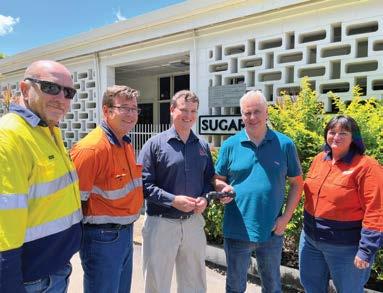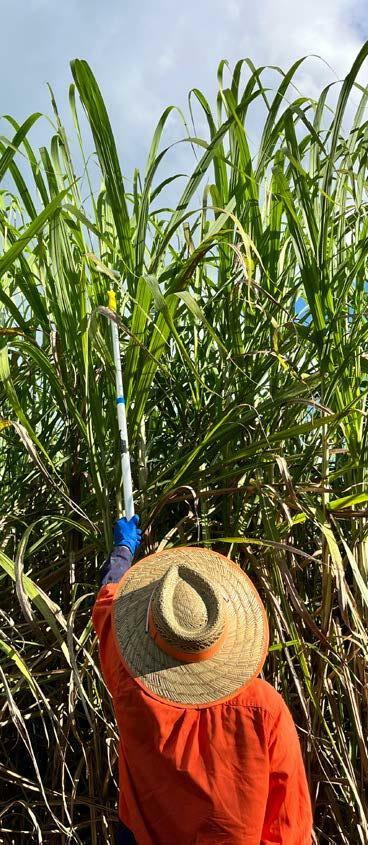
3 minute read
Strategic Pillar 5 – Commercial benefits and rewards
Take our research work and investments to the next level by securing investors and funding and extracting commercial value from our intellectual property, research capability, facilities and strategic partnerships
While much of SRA’s work under this pillar focused on setting the foundation for the period ahead, there were several notable areas of progress.
Advertisement
See & SprayTM Select Technology
SRA is collaborating with University of Southern Queensland, Horticulture Innovation Australia and Cotton Research and Development Corporation to commercialise the intellectual property for vision-based precision spray technology for use on fallow ground with John Deere, as part of their See & SprayTM Select technology. Typical herbicide savings delivered through the technology average 77 per cent, demonstrating the value and impact that comes from solutionfocused investment in technologies that address significant industry challenges. Additionally, the crosssectoral collaboration increases the total impact from investment and underpins strong product focus between research providers, investors and commercial partners.
Expand funding and investment partners
As outlined under the cross-sectoral research section of this report, SRA is engaging with Agricultural Innovation Australia to develop cross-sectoral, multi-disciplinary solutions in areas of common priority, including climate resilience and carbon accounting. This provides significant leverage of SRA investment with other research and development corporations and private partners to deliver solutions for the sugar industry.
Plant Breeding Rights
SRA maintains on behalf of the industry, control of intellectual property through Plant Breeding Rights and has rights to charge royalties. While rates for the Australian industry are currently set to zero, international opportunities are being explored. The 2022 Plant Breeding Rights portfolio comprises 65 registered varieties representing more than 97 per cent of commercial production. Fifteen new varieties reached Granted status over the past two years, while 19 varieties have had PBR terminated.
Cane Mapping and Analysis
SRA invested in defining the development requirements for CaneMAPPS – Cane Mapping and Analysis for Productivity, Profitability and Sustainability. The objective is to provide growers a central digital portal for data-driven decisionmaking to enable optimisation of their farming operations to achieve profitability and productivity, while ensuring compliance with legislation and community expectations regarding environmental sustainability. The platform will enable interrogation of SRA systems – such as SPIDNet and QCANESelect – alongside external databases - including soil and weather resources; importing and storing farm and industry data; and enabling automation of current data processing procedures to enable timely, data-driven discussion and decision-making.
Fee for service and consulting activities
Fee for service and consulting activities included drone-based monitoring of field trials, sugarcane variety identity verification using DNA technology, validation of cane loss monitors, testing new chemical products for control of soil borne pathogens and near infrared (NIR) scanning services to milling companies. SRA also received payment through externally funded initiatives to support targeted grower adoption initiatives.
Near infrared services
SRA provides NIR calibration support services to multiple Australian mills, one international mill and four Queensland bulk sugar terminals, earning a support fee for these services. Instruments supported include cane analysis systems, bagasse analysis systems, sugar analysis systems and benchtop laboratory systems. Online cane analysis systems supported by SRA are installed at the beginning of a mill’s milling train, with the instrument able to scan the incoming cane every 10 seconds. These NIR scans are automatically processed through SRA’s calibrations, with predictions for 29 cane parameters being generated. The results are used by mill staff to assess cane quality, support mill process control decisions, for internal auditing purposes and to support grower cane payment. 13 cane analysis systems delivered 8.53 million scans across 213,000 cane consignments this equates to approximately 1,113 days of continuous scanning about 9.92 million tonnes of cane was assessed by NIR in Australia. The online bagasse analysis system is used for mill process control and bagasse quality assurance. The online sugar analysis system is used for process control and sugar quality assurance. Benchtop NIR systems are installed in mill laboratories (five instruments) and at the bulk sugar terminals (four instruments). Mill laboratories use these systems to predict various parameters (e.g., pol, moisture, fibre) on different process streams (e.g., molasses, massecuite, raw sugar). Mills use these data to support process control decisions and for quality assurance. Five mill laboratory NIR systems provided predictions on 20,600 samples scanned. The bulk sugar terminals use benchtop NIR systems to inform blending ratios for quality control of Australia’s export raw sugar.
Strategic Pillar 5: Outcome measures

Deliver net returns from commercial activities
Target – Deliver more than $4 million in net returns per annum by 2026. Result – 2021/22 was a foundational year under this pillar. This measure will be reported in future annual reports.








